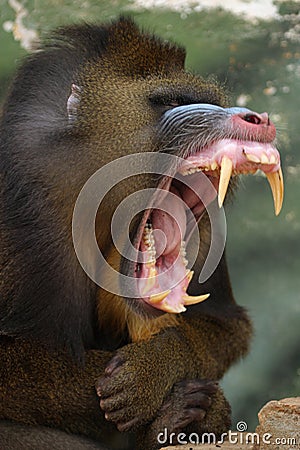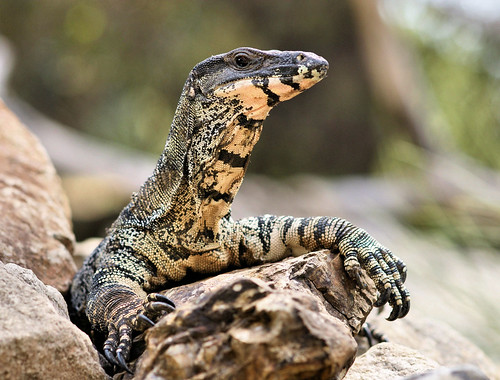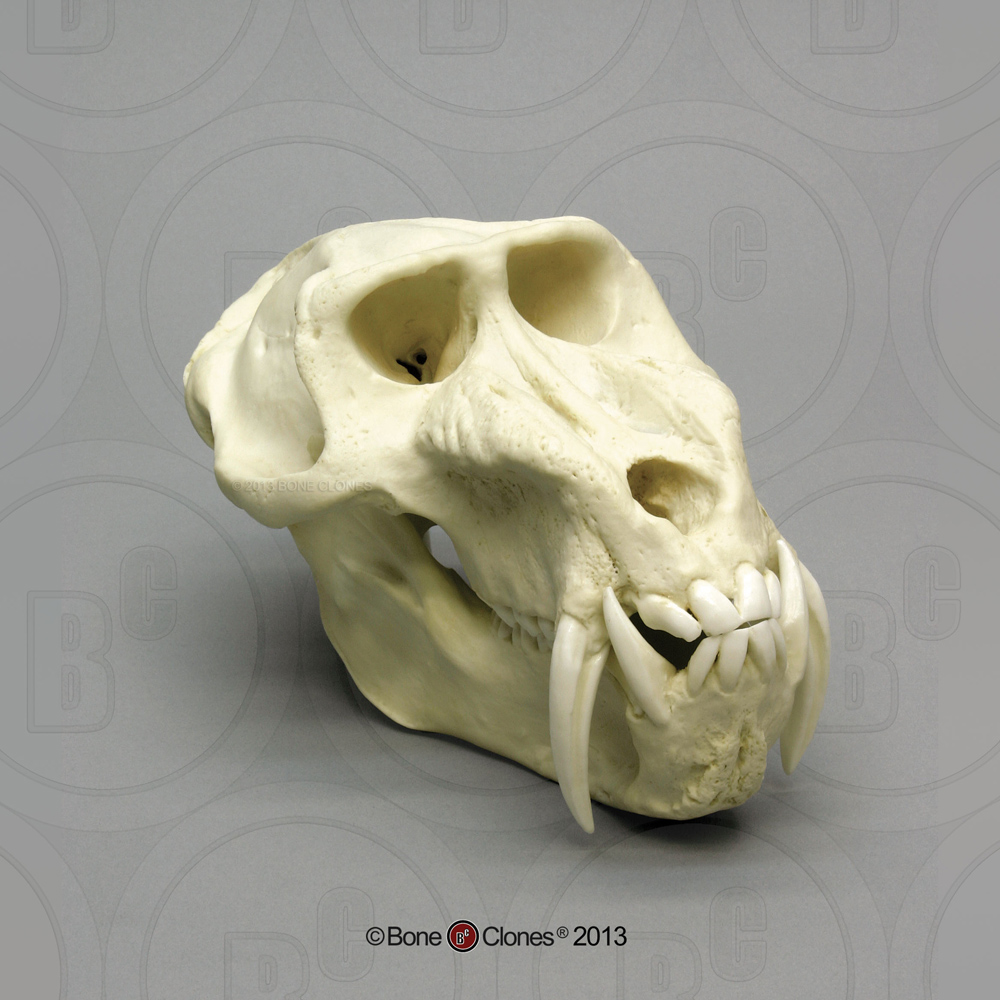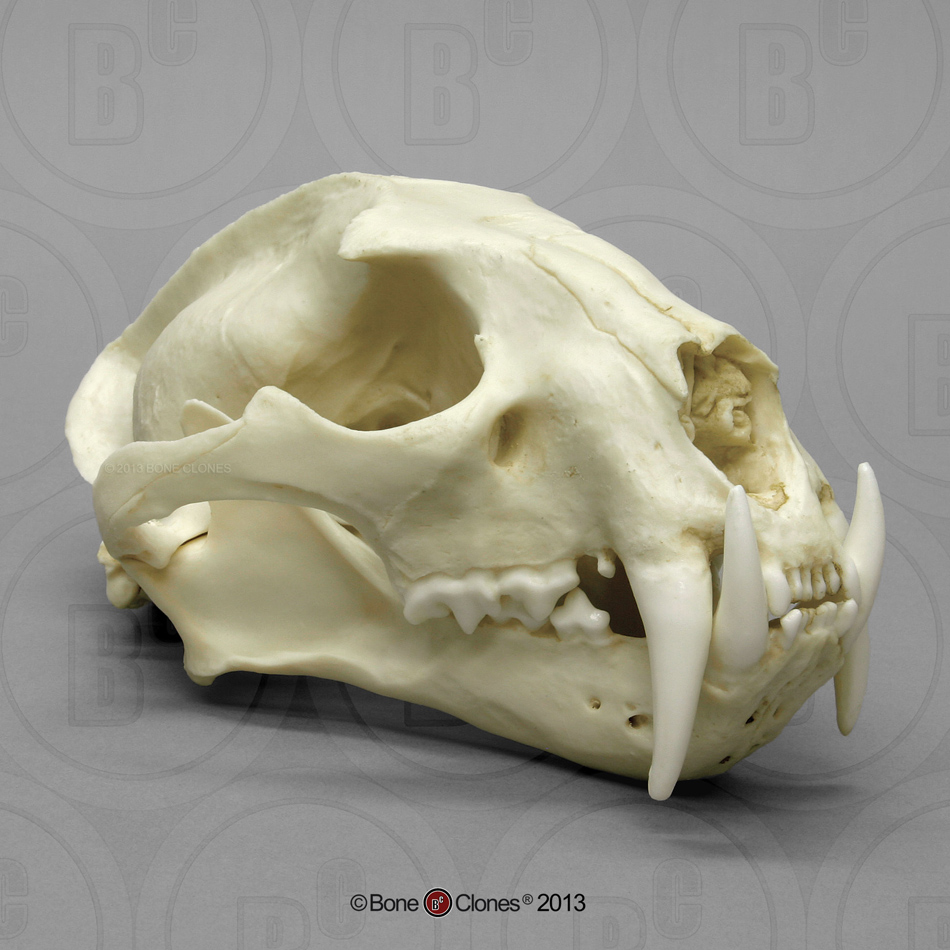Post by Runic on Nov 14, 2013 23:41:58 GMT 5
Mandrill

The mandrill (Mandrillus sphinx) is a primate of the Old World monkey (Cercopithecidae) family,[4] closely related to the baboons and even more closely to the drill. It is found in southern Cameroon, Gabon, Equatorial Guinea, and Congo. Mandrills mostly live in tropical rainforests and forest-savanna mosaics. They live in groups called hordes. Mandrills have an omnivorous diet consisting mostly of fruits and insects. Their mating season takes place from June to October.
Both the mandrill and the drill were once classified as baboons in genus Papio, but recent research has determined they should be separated into their own genus, Mandrillus.[4] Mandrills are the world's largest monkeys. Charles Darwin wrote in The Descent of Man that "no other member in the whole class of mammals is coloured in so extraordinary a manner as the adult male mandrills."[5] The mandrill is classified as vulnerable by IUCN.
The mandrill is the most colorful primate. It has an olive green or dark grey pelage with yellow and black bands and a white belly. Its hairless face has an elongated muzzle with distinctive characteristics such as a red stripe down the middle and protruding blue ridges on the sides. It also has red nostrils and lips, a yellow beard and white tuffs. The areas around the genitals and the anus are multi-colored, being colored red, pink, blue, scarlet, and purple.[6] They also have pale pink ischial callosities.[6] The coloration of the animal is more pronounced in dominant adult males. Both sexes have chest glands which are used in olfactory communication. These, too, are more prominent in dominant adult males.[7] Males also have longer canines than females, with an average of 4.5 cm (1.8 in) and 1.0 cm, respectively.[8]
The mandrill has one of the greatest sexual dimorphisms among the primates.[9] Males typically weigh 19–37 kg (42–82 lb), with an average mass of 32.3 kg (71 lb). Females weigh roughly half as much as the male, at 10–15 kg (22–33 lb) and an average of 12.4 kg (27 lb).[10] Exceptionally large males can weigh up to 54 kg (119 lb).[11][12][13] The average male is 75 to 95 cm (30 to 37 in) long and the female is 55–66 cm (22–26 in), with the short tail adding another 5–10 cm (2.0–3.9 in).[14][15] The shoulder height while on all fours can range from 45 to 50 cm (18 to 20 in) in females and 55 to 65 cm (22 to 26 in) in males. The male Mandrill is the heaviest monkey in the world, although its total length is relatively short due to its vestigial tail and, due to its high sexual dimorphism, baboons such as the Chacma and Olive average around the same weight. Compared to the largest baboons, the mandrill is more ape-like in structure, with a muscular and compact build, shorter, thicker limbs that are longer in the front and almost no tail.[16][17][18] Mandrills can survive up to 31 years in captivity. Females reach sexual maturity at about 3.5 years.
Clouded Leopard

The clouded leopard (Neofelis nebulosa) is a cat found from the Himalayan foothills through mainland Southeast Asia into China, and has been classified as Vulnerable in 2008 by IUCN. Its total population size is suspected to be fewer than 10,000 mature individuals, with a decreasing population trend, and no single population numbering more than 1,000 adults.[2]
The clouded leopard is considered to form an evolutionary link between the big cats and the small cats.[3]
The Sunda clouded leopard (Neofelis diardi) found on Sumatra and Borneo is genetically distinct and has been considered a separate species since 2006.[4][5]
Both Neofelis species are the smallest of the big cats, and are not closely related to the leopard.[6]
The fur of clouded leopards is of a dark grey or ochreous ground-colour, often largely obliterated by black and dark dusky-grey blotched pattern. There are black spots on the head, and the ears are black. Partly fused or broken up stripes run from the corner of the eyes over the cheek, from the corner of the mouth to the neck, and along the nape to the shoulders. Elongated blotches continue down the spine and form a single median stripe on the loins. Two large blotches of dark dusky-grey hair on the side of the shoulders are each emphasized posteriorly by a dark stripe, which passes on to the fore leg and breaks up into irregular spots. The flanks are marked by dark dusky-grey irregular blotches bordered behind by long, oblique irregularly curved or looped stripes. These blotches yielding the clouded pattern suggest the English name of the cat. The underparts and legs are spotted, and the tail is marked by large, irregular, paired spots.[7]
Their irises are usually either greyish-green or brownish-yellow in color. Their legs are short and stout, with broad paws. They have rather short limbs compared to the other big cats, but their hind limbs are longer than their front limbs to allow for increased jumping and leaping capabilities. Their ulnae and radii are not fused, which also contributed to a greater range of motion when climbing trees and stalking prey.[8]
Melanistic clouded leopards are uncommon. Clouded leopards weigh between 11.5 and 23 kg (25 and 51 lb). Females vary in head-to-body length from 68.6 to 94 cm (27.0 to 37 in), with a tail 61 to 82 cm (24 to 32 in) long. Males are larger at 81 to 108 cm (32 to 43 in) with a tail 74 to 91 cm (29 to 36 in) long.[9] Their shoulder height varies from 50 to 55 cm (20 to 22 in).[10]
They have exceptionally long, piercing canine teeth, the upper being about three times as long as the basal width of the socket.[7] The upper pair of canines may measure 4 cm (1.6 in) or longer.[9] They are often referred to as a “modern-day saber tooth” because they have the largest canines in proportion to their body size, matching the tiger in canine length. The first premolar is usually absent, and they also have a very distinct long and slim skull with well-developed occipital and sagittal crests to support the enlarged jaw muscles.[8]

The mandrill (Mandrillus sphinx) is a primate of the Old World monkey (Cercopithecidae) family,[4] closely related to the baboons and even more closely to the drill. It is found in southern Cameroon, Gabon, Equatorial Guinea, and Congo. Mandrills mostly live in tropical rainforests and forest-savanna mosaics. They live in groups called hordes. Mandrills have an omnivorous diet consisting mostly of fruits and insects. Their mating season takes place from June to October.
Both the mandrill and the drill were once classified as baboons in genus Papio, but recent research has determined they should be separated into their own genus, Mandrillus.[4] Mandrills are the world's largest monkeys. Charles Darwin wrote in The Descent of Man that "no other member in the whole class of mammals is coloured in so extraordinary a manner as the adult male mandrills."[5] The mandrill is classified as vulnerable by IUCN.
The mandrill is the most colorful primate. It has an olive green or dark grey pelage with yellow and black bands and a white belly. Its hairless face has an elongated muzzle with distinctive characteristics such as a red stripe down the middle and protruding blue ridges on the sides. It also has red nostrils and lips, a yellow beard and white tuffs. The areas around the genitals and the anus are multi-colored, being colored red, pink, blue, scarlet, and purple.[6] They also have pale pink ischial callosities.[6] The coloration of the animal is more pronounced in dominant adult males. Both sexes have chest glands which are used in olfactory communication. These, too, are more prominent in dominant adult males.[7] Males also have longer canines than females, with an average of 4.5 cm (1.8 in) and 1.0 cm, respectively.[8]
The mandrill has one of the greatest sexual dimorphisms among the primates.[9] Males typically weigh 19–37 kg (42–82 lb), with an average mass of 32.3 kg (71 lb). Females weigh roughly half as much as the male, at 10–15 kg (22–33 lb) and an average of 12.4 kg (27 lb).[10] Exceptionally large males can weigh up to 54 kg (119 lb).[11][12][13] The average male is 75 to 95 cm (30 to 37 in) long and the female is 55–66 cm (22–26 in), with the short tail adding another 5–10 cm (2.0–3.9 in).[14][15] The shoulder height while on all fours can range from 45 to 50 cm (18 to 20 in) in females and 55 to 65 cm (22 to 26 in) in males. The male Mandrill is the heaviest monkey in the world, although its total length is relatively short due to its vestigial tail and, due to its high sexual dimorphism, baboons such as the Chacma and Olive average around the same weight. Compared to the largest baboons, the mandrill is more ape-like in structure, with a muscular and compact build, shorter, thicker limbs that are longer in the front and almost no tail.[16][17][18] Mandrills can survive up to 31 years in captivity. Females reach sexual maturity at about 3.5 years.
Clouded Leopard

The clouded leopard (Neofelis nebulosa) is a cat found from the Himalayan foothills through mainland Southeast Asia into China, and has been classified as Vulnerable in 2008 by IUCN. Its total population size is suspected to be fewer than 10,000 mature individuals, with a decreasing population trend, and no single population numbering more than 1,000 adults.[2]
The clouded leopard is considered to form an evolutionary link between the big cats and the small cats.[3]
The Sunda clouded leopard (Neofelis diardi) found on Sumatra and Borneo is genetically distinct and has been considered a separate species since 2006.[4][5]
Both Neofelis species are the smallest of the big cats, and are not closely related to the leopard.[6]
The fur of clouded leopards is of a dark grey or ochreous ground-colour, often largely obliterated by black and dark dusky-grey blotched pattern. There are black spots on the head, and the ears are black. Partly fused or broken up stripes run from the corner of the eyes over the cheek, from the corner of the mouth to the neck, and along the nape to the shoulders. Elongated blotches continue down the spine and form a single median stripe on the loins. Two large blotches of dark dusky-grey hair on the side of the shoulders are each emphasized posteriorly by a dark stripe, which passes on to the fore leg and breaks up into irregular spots. The flanks are marked by dark dusky-grey irregular blotches bordered behind by long, oblique irregularly curved or looped stripes. These blotches yielding the clouded pattern suggest the English name of the cat. The underparts and legs are spotted, and the tail is marked by large, irregular, paired spots.[7]
Their irises are usually either greyish-green or brownish-yellow in color. Their legs are short and stout, with broad paws. They have rather short limbs compared to the other big cats, but their hind limbs are longer than their front limbs to allow for increased jumping and leaping capabilities. Their ulnae and radii are not fused, which also contributed to a greater range of motion when climbing trees and stalking prey.[8]
Melanistic clouded leopards are uncommon. Clouded leopards weigh between 11.5 and 23 kg (25 and 51 lb). Females vary in head-to-body length from 68.6 to 94 cm (27.0 to 37 in), with a tail 61 to 82 cm (24 to 32 in) long. Males are larger at 81 to 108 cm (32 to 43 in) with a tail 74 to 91 cm (29 to 36 in) long.[9] Their shoulder height varies from 50 to 55 cm (20 to 22 in).[10]
They have exceptionally long, piercing canine teeth, the upper being about three times as long as the basal width of the socket.[7] The upper pair of canines may measure 4 cm (1.6 in) or longer.[9] They are often referred to as a “modern-day saber tooth” because they have the largest canines in proportion to their body size, matching the tiger in canine length. The first premolar is usually absent, and they also have a very distinct long and slim skull with well-developed occipital and sagittal crests to support the enlarged jaw muscles.[8]












